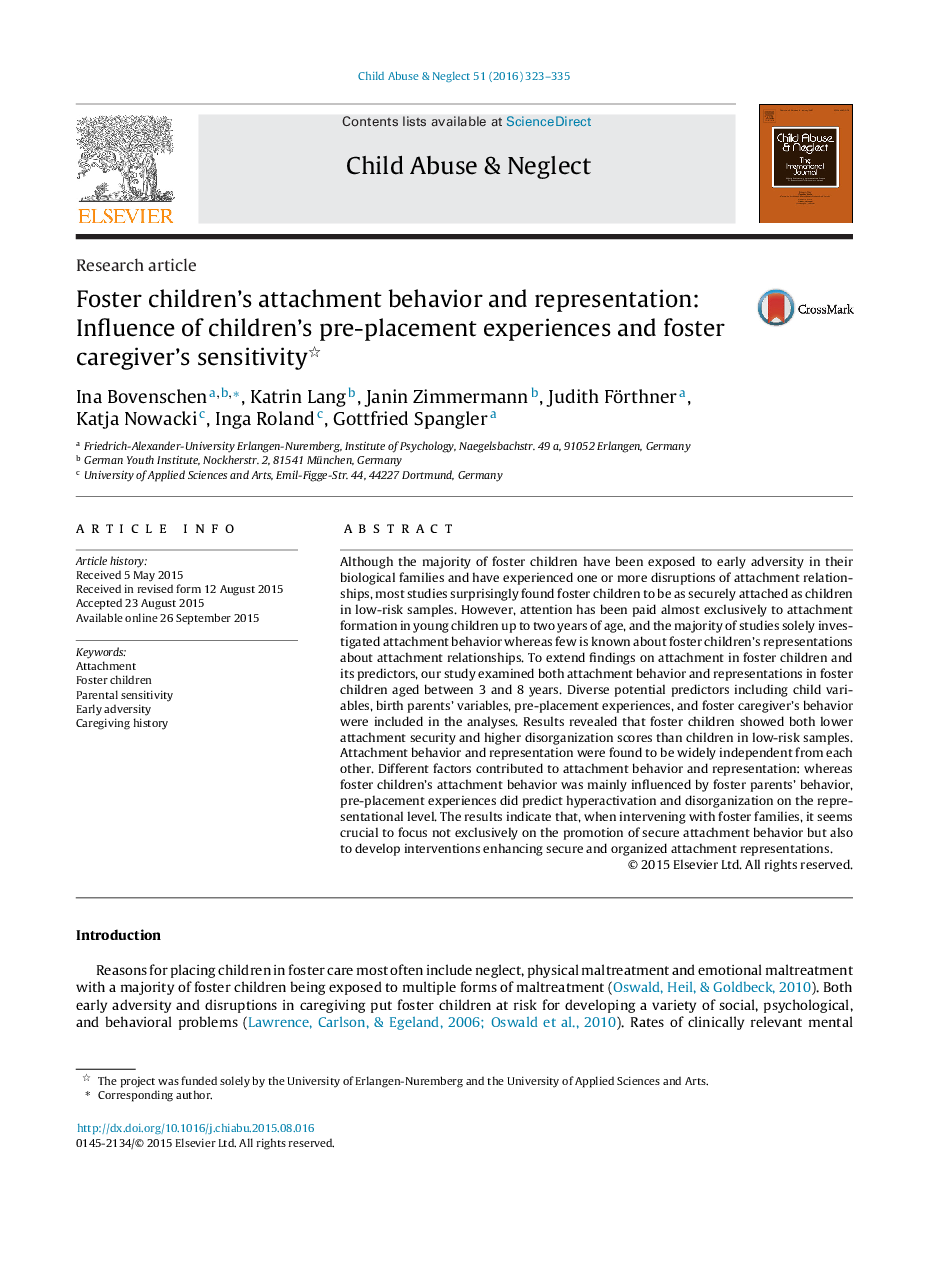| کد مقاله | کد نشریه | سال انتشار | مقاله انگلیسی | نسخه تمام متن |
|---|---|---|---|---|
| 6832445 | 617427 | 2016 | 13 صفحه PDF | دانلود رایگان |
عنوان انگلیسی مقاله ISI
Foster children's attachment behavior and representation: Influence of children's pre-placement experiences and foster caregiver's sensitivity
ترجمه فارسی عنوان
رفتار و نمایندگی وابستگی فرزندان فاستر: تأثیر تجارب پیش از ازدواج کودکان و حساسیت مراقبان پرستار
دانلود مقاله + سفارش ترجمه
دانلود مقاله ISI انگلیسی
رایگان برای ایرانیان
کلمات کلیدی
ضمیمه، فرزندان فاستر، حساسیت والدین، زودرس زودرس، تاریخ مراقبت
ترجمه چکیده
اگرچه اکثریت فرزندان پرستار در معرض ابتلا به بیماری های زودرس در خانواده های زیست محیطی قرار دارند و یک یا چند اختلال روابط دلبستگی را تجربه کرده اند، اغلب مطالعات شگفت آور فرزندان پرستار را به عنوان محرمانه به عنوان کودکان در نمونه های کم خطر مورد توجه قرار می دهند. با این حال توجه تقریبا به طور انحصاری برای شکل گیری دلبستگی در کودکان کمتر از دو ساله پرداخت شده است و اکثریت مطالعات تنها رفتار دلبستگی را مورد بررسی قرار داده اند، در حالی که تعداد کمی از آنها در مورد بازنمایی های فرزندان فرزندان درباره روابط دلبستگی شناخته شده است. برای به دست آوردن یافته های مربوط به دلبستگی در فرزندان فرزندان و پیش بینی کننده های آن، مطالعه ما هر دو رفتار دلبستگی و نمایندگی در فرزندان طفل را بین 3 تا 8 سال بررسی کرد. پیش بینی های بالقوه گوناگونی از جمله متغیرهای کودک، متغیرهای تولد والدین، تجربیات پیش از قرار دادن و رفتار مراقب پرستاران در تحلیل ها گنجانده شده است. نتایج نشان داد که کودکان پرستار هر دو ضریب پایبندی پایین و نمره ناهنجاری بالاتر نسبت به کودکان در نمونه های کم خطر را نشان دادند. رفتار و نمایندگی پیوستگی به طور گسترده ای مستقل از یکدیگر بودند. عوامل مختلفی به رفتار و نمایندگی دلبستگی منجر شد: در حالی که رفتار دلبستگی فرزندان به طور عمده توسط رفتار والدین تحت تاثیر قرار می گرفت، تجربیات پیش از بارداری پیش بینی کننده فعالیت بیش فعالی و اختلال در سطح نمایندگی بود. نتایج نشان می دهد که در هنگام مداخله با خانواده های پرستار، به نظر می رسد که ضروری است که نه تنها بر ارتقاء رفتار دلبستگی امن تمرکز نکنیم، بلکه به منظور ایجاد مداخلات برای تقویت نمایندگی های دلبستگی ایمن و سازمان یافته.
موضوعات مرتبط
علوم پزشکی و سلامت
پزشکی و دندانپزشکی
پریناتولوژی (پزشکی مادر و جنین)، طب اطفال و بهداشت کودک
چکیده انگلیسی
Although the majority of foster children have been exposed to early adversity in their biological families and have experienced one or more disruptions of attachment relationships, most studies surprisingly found foster children to be as securely attached as children in low-risk samples. However, attention has been paid almost exclusively to attachment formation in young children up to two years of age, and the majority of studies solely investigated attachment behavior whereas few is known about foster children's representations about attachment relationships. To extend findings on attachment in foster children and its predictors, our study examined both attachment behavior and representations in foster children aged between 3 and 8 years. Diverse potential predictors including child variables, birth parents' variables, pre-placement experiences, and foster caregiver's behavior were included in the analyses. Results revealed that foster children showed both lower attachment security and higher disorganization scores than children in low-risk samples. Attachment behavior and representation were found to be widely independent from each other. Different factors contributed to attachment behavior and representation: whereas foster children's attachment behavior was mainly influenced by foster parents' behavior, pre-placement experiences did predict hyperactivation and disorganization on the representational level. The results indicate that, when intervening with foster families, it seems crucial to focus not exclusively on the promotion of secure attachment behavior but also to develop interventions enhancing secure and organized attachment representations.
ناشر
Database: Elsevier - ScienceDirect (ساینس دایرکت)
Journal: Child Abuse & Neglect - Volume 51, January 2016, Pages 323-335
Journal: Child Abuse & Neglect - Volume 51, January 2016, Pages 323-335
نویسندگان
Ina Bovenschen, Katrin Lang, Janin Zimmermann, Judith Förthner, Katja Nowacki, Inga Roland, Gottfried Spangler,
